The sinking of the SMS Szent István 1918.
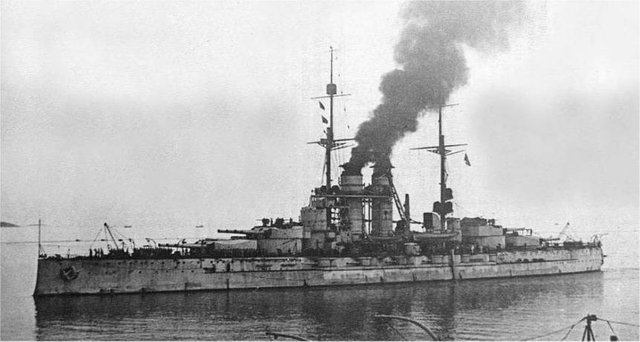
The SMS Szent Istvan was a dreadnought Tegetthoff-class battleship of the Austro-Hungarian navy during WWI. The ship was sunk in the Adriatic sea near Premuda island just a few kilometers of the Dalmatian coast on the 10th of June 1918. A few months before the capitulation of the Austro-Hungarian empire its dissolution and the end of WWI. The ship capsized and the lives of 89 men were lost the rest of the crew 976 sailors and officers were saved. Casualties are low due to the k.u.k. Navy's policy that every sailor in service has to be taught to swim, what was unusual for Navy service of that time. The sinking of the Szent Istvan was filmed from its sister ship the SMS Tegetthoff and was the first filming in history of a destroyer sinking in war.
The Austro-Hungarian empire and its Navy short introduction
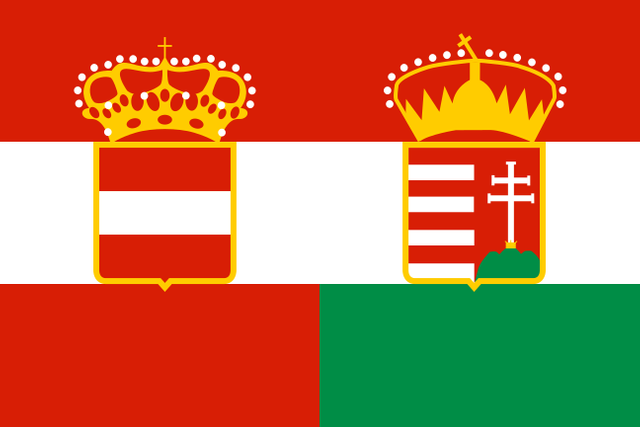
The empire also known as the Dual Monarchy was made out of the union between the Austrian Empire under the rule of the Habsburg monarchy and the Kingdom of Hungary. The country existed from 1867. till 1918. it dissolved after its defeat in WWI. The empire was the second largest country in Europe during the late 19th and early 20th century with the third largest population after Russia and Germany. It had also one of the largest industrial production in the world, situated in the northern part of the empire in today's Austria and Hungary, making these two countries the cultural and educational centers of the Empire. It was a wast multinational empire spreading over large areas of central, eastern and southeastern Europe covering almost an area of 680 000 square kilometers with a population of about 53 000 000 people. Austria and Hungary were equals and questions of foreign affairs and the military were under a joint council the rest of both governments was autonomous and the rule over the empire was divided between the two countries. The Dual Monarchy was one of the great powers in Europe at the time but it was in deep trouble. Over the decade's tensions and revolts grew from various ethnic groups under the Austro-Hungarian rule as these minorities dreamed of their own independent nations. The lost of WWI and more and more ethnic uprisings were the last nail into the coffin of what was once a great power of Europe.
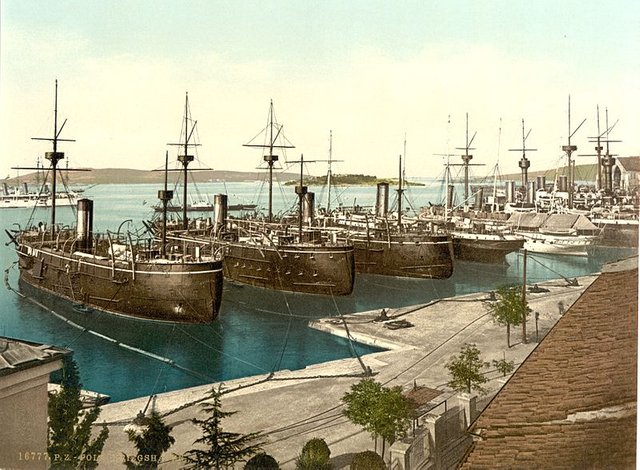
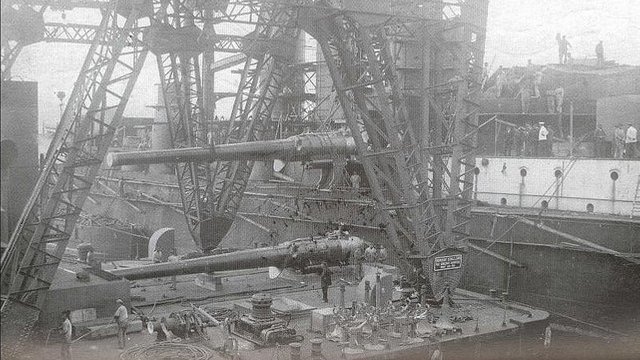
The navy of the empire was known as the k.u.k. Kriegsmarine short for kaiserliche und konigliche Kriegsmarine (in eng. Imperial and Royal War Navy) ships in the service of the empire had the designation SMS Seiner Majestät Schiff (in eng. His Majesty Schip) in front of the ships name. Almost 34 000 men served in the Navy of which more than 32 % were croatian sailors. The city of Pula in today's Croatia (eng. Pola) was the base of Austro-Hungarian Navy operations with a Naval Observatory, the empires naval military cemetery and church. Pula was home to one of the largest floating dry docks in the Mediterranean where the majority of the fleet was built. Besides Pula, today's Triest was also one of the largest shipyards of the empire. Other major harbors on the eastern Adriatic coast where in Rijeka, Šibenik and Boka Kotorska (Montenegro). The Austro-Hungarian empire had a sufficient naval force of 98 ships. The fleet was sufficient for defending the Adriatic sea and holding the Italians as the switch sides in 1915. The empires fleet had a lot of problems the same as the rest of the empire, the navy was made of sailors from the entire empire so there was the language barrier. The majority of the Naval command was made of the Austrian and Hungarian nobility. Two major events that reflected the problems of the Navy were the mutiny of sailors in Kotor Naval base and the sinking of the dreadnaught battleship Szent Istvan. Both events occurred in 1918. the last year of WWI foretelling the faith of the empire.
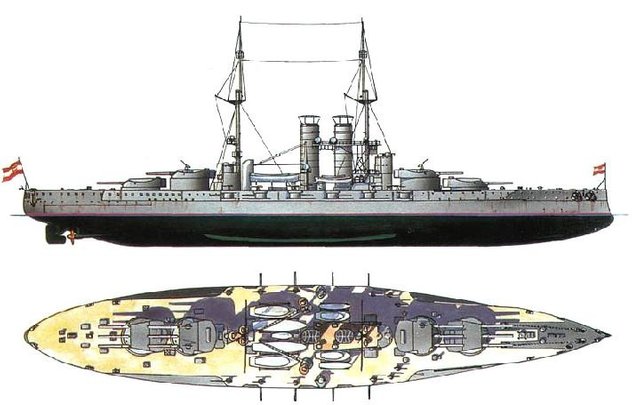
The sinking of the SMS Szent István
The Tegetthoff-class dreadnaught battleship SMS Szent Istvan was started in 1912 and launched in 1914. It was the only warship build by the Hungarian government in the Danubis shipyard in Rijeka, the shipyard today is called 3. Mai. Battleship Szent Istvan was named after the first Hungarian christian king Saint Stephen I.(975 - 1038) it was the first ship equipped with triple main turrets guns. The Szent Istvan had a displacement of 20 000 tons a length of 152.18 meters a beam of 28 meters and a draught of 8.6 meters. She was equipped with two steam turbines powered by twelve boilers in two boiler rooms producing enough power to reach a speed of twenty knots. The firing power was enormous with twelve 30.5 centimeter K10 guns in four turrets, twelve 15 centimeter K10 guns, a total of fifteen 7 centimeter guns on the upper deck and 4 torpedo holes on the bow, stern and on each broadside. The entire ship was heavily armored with up to 28 millimeters thick plates.
The launch of the battleship on the 17th of January 1914 was overshadowed by a series of events. First of all the building of the warship was delayed for several years. Second, it was customary for the emperor or his heir to attend the launch of any major warship of the fleet. As the Franz Joseph was feeling ill his son and heir Archduke Franz Ferdinand was supposed to be in Rijeka. Due to his ant-Hungarian views, he refused to attend the launching of Szent Istvan. At the launching ceremony, the anchor chain dropped killing one and injuring a second dockworker. Szent Istvan was commissioned in 1915 and for the majority of the war did not leave the port in Pula except for gunnery practice. During the 1918 Otranto blocked led by the Allies the Szent Istvan would finally see combat.
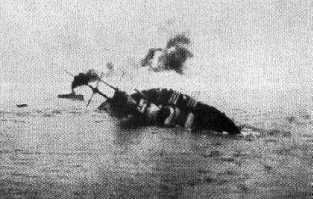
Konteradmiral Miklos Horthy planed an offensive against the Allies at Otranto straight. Horthy left Pula harbor on June 8th with the SMS Viribus Unitis and the SMS Prince Eugen two Tegethoff battleships. The day after on the 9th the SMS Szent Istvan and the SMS Tegetthoff followed south to escort six torpedo boats and one destroyer to the rendezvous port of Slano north of Dubrovnik so the coordinated attack on the Otranto blockade could begin. On their way south on the 10th around 3:15 am the convoy was intercepted by two Italian MAS torpedo boats as they were returning from a patrol of the Dalmatian coast. The Italians engaged in battle the two MAS torpedo boats were outmaneuvering the Austro-Hungarian escorts. During the attack, the SMS Szent Istvan was hit with two torpedos from one of the Italians, with two direct hits to the boiler rooms. Shortly after the incident, SMS Szent Istvan rejoined the convoy around 4:45 am. The boiler rooms flooded quickly tilting the ship about 10 degrees, counterflooding of portside magazines did not help and the attempts to plug the holes failed and water continued to flood departments of the boiler rooms killing the water pumps leaving electricity only for the lights. The last attempt to save the ship by throwing the ammunition overboard and turning the turrets portside to produce counter lift was ineffective and by now it was clear that the Szent Istvan was doomed. The SMS Szent Istvan finally capsized at 6:05 am off the island Premuda 89 sailors died in the sinking most of them were in the boiler rooms. The casualty count was low due to the k.u.k. navy police that every sailor must learn to swim before entering service in the Navy.
The footage of the sinking was taken from the SMS Tegetthoff by the official film crew, the sinking lasted about an hour. Today the wreck of the Szent Istvan lays upside down at a depth of 66meters just off the Dalmatian island Premuda north of the city Zadar.
Today the shipwreck is placed under protection by the Croatian ministry of culture as a memorial of war and the last resting place of the 89 crew members that died here. Casual diving is prohibited in and around the wreck.
Bibliography:
- https://en.wikipedia.org/wiki/Austria-Hungary
- https://en.wikipedia.org/wiki/Austro-Hungarian_Navy
- https://hr.wikipedia.org/wiki/SMS_Szent_Istv%C3%A1n
- http://www.naval-history.net/WW1NavyAustrian.htm
- http://croatian-treasure.com/szent.html
- Sieche, Erwin, Conway's All the Worlds Fighting Ships 1906 - 1921., Annapolis, 1986.
Great story, great info. Keep it up!
Thanks stay tuned there will be more 😄
Congratulations, Your Post Has Been Added To The Steemit Worldmap!
Author link: http://steemitworldmap.com?author=zija2022
Post link: http://steemitworldmap.com?post=the-sinking-of-the-sms-szent-istvan-1918
Want to have your post on the map too?
Great story, I read somewhere that the liutenant in command of the italian boat was punished for something, cant remember, and was demoted to the torpedo boat. I think after this he redeemed himself :)
His name was Luigi Rizzo his nickname was The Sinker and few months before sinking the Szent Istvan he sunk the SMS Wien in Triest. He was charged with sabotage in WWII by the fascists.
I mixed up wars then. Really enjoyed reading this
It's nice and refreshing to see some history
Lepo je videti kvalitetan istorijski članak
Hvala na komplimentu :-)
Good old times :D, citao sam dosta o borbama na atlantiku ww2, kolko je tamo brodovlja potopljeno..
I u Jadranu nema cega nema na dnu mora :-)
Thanks read with interest and signed up to you.
in general to me as a resident of the city of Khabarovsk in the Far East of Russia is extremely interesting The theme of Austro-Hungarian and participation in the First World War because in our city there were a lot of prisoners of war from Austro-Hungarian ( including Thivadar Soros))) during the Great War, including the entire crew of the cruiser "Magdeburg", on which all the encryption codes of the German Fleet were seized by Russian Imperial Navy in the end of 1914. It will be necessary to write how the corvett-captain Richard Habenicht ( captain of "Magdebourg") rushed from the snow-covered Khabarovsk through the river to neighboring China to escape))
Thank you for your comment. The wreck is close to where I live and not many know about it. It would be interesting to read about R. Habenicht looking forward to it.
Wow, such a great read.
You really took time to analyze the whole scenario.
Congratulations! This post has been upvoted from the communal account, @minnowsupport, by zija2022 from the Minnow Support Project. It's a witness project run by aggroed, ausbitbank, teamsteem, theprophet0, someguy123, neoxian, followbtcnews, and netuoso. The goal is to help Steemit grow by supporting Minnows. Please find us at the Peace, Abundance, and Liberty Network (PALnet) Discord Channel. It's a completely public and open space to all members of the Steemit community who voluntarily choose to be there.
If you would like to delegate to the Minnow Support Project you can do so by clicking on the following links: 50SP, 100SP, 250SP, 500SP, 1000SP, 5000SP.
Be sure to leave at least 50SP undelegated on your account.
Ilove history.And am happy to read this post.